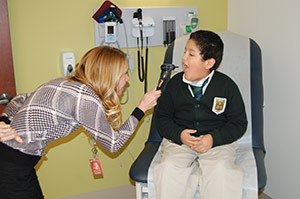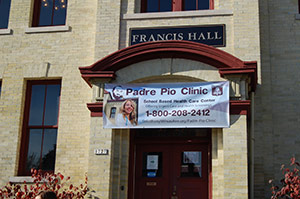Luz Tellez admits that, as a parent with four children, it’s a challenge to keep them healthy.
 Dana Rodriguez, pediatric nurse practitioner and Padre Pio Clinic director, examines St. Anthony fourth grader Isael Gonzalez at the clinic in early November. (Catholic Herald photo by Ricardo Torres)“It can be difficult to make ends meet,” she said “There’s a lot of expenses with children.”
Dana Rodriguez, pediatric nurse practitioner and Padre Pio Clinic director, examines St. Anthony fourth grader Isael Gonzalez at the clinic in early November. (Catholic Herald photo by Ricardo Torres)“It can be difficult to make ends meet,” she said “There’s a lot of expenses with children.”
Her current health care plan, which includes a large deductible, doesn’t help her much.
“It feels like almost not having insurance because by the time you cover everything, you need to start all over again,” Tellez said.
The cost of health care has had an impact on her family, but with her son attending St. Anthony High School, Milwaukee, things have been easier, thanks to the Padre Pio Clinic.
Opened a year ago, the clinic has been used frequently by the Tellez family.
“I feel supported,” Tellez said. “If before graduation he needs the help for him to succeed in that area (physically) … I have something that supports me.”
The clinic serves approximately 15 to 20 students a day with a total of 1,900 using it throughout year. It offers an array of urgent care and preventative health services, including diagnostic testing, physicals, vision and dental screenings, immunizations and TB testing. According to clinic officials, in the year it’s been in operation, it has been responsible for increasing the student immunization rate to 99 percent.
About 25 percent of St. Anthony students don’t have health insurance.
“It’s a cost savings to the families, because they don’t have to go to outside clinics and pay,” Dana Rodriguez, clinic director and wife of school president Zeus Rodriguez, said. “And a lot of people, if they have to pay, they may wait longer and then it may get more severe.”
Since opening last year, the clinic has provided more than $75,000 in free services to members of the community, according to a press release issued by the school.
The clinic received a $500,000 federal grant which led to the extensive expansion and remodeling project that created a main office inside the historic Francis Hall building on South Ninth Street. More than $200,000 of the federal grant was used for diagnostic and medical equipment.
There are three examination rooms at the main location on South Ninth and West Mitchell streets. Inside the  Since opening last year, the Padre Pio Clinic, located at St. Anthony School, Milwaukee, has provided more than $75,000 in free services to members of the community, according to a press release issued by the school. (Catholic Herald photo by Ricardo Torres)building, patients may feel as though they are in a Silicon Valley tech start-up with a mixture of rustic brick walls and offices with modern technology.
Since opening last year, the Padre Pio Clinic, located at St. Anthony School, Milwaukee, has provided more than $75,000 in free services to members of the community, according to a press release issued by the school. (Catholic Herald photo by Ricardo Torres)building, patients may feel as though they are in a Silicon Valley tech start-up with a mixture of rustic brick walls and offices with modern technology.
Each of the four St. Anthony campuses has an examination room and the school provides a shuttle to move students from different schools to the main location.
“Having it here at the school and providing it free of cost prevents things from escalating,” Dana Rodriguez said. “We do bill health insurance for those who have it.”
There are two full-time staffers, but there is a rotation of nurse practitioners, nursing assistants, a doctor and dentist.
The responses from families have been filled with gratitude.
“They buy me Christmas presents; they’re always calling and saying, ‘Thank you,’” Dana Rodriguez said.
A ceremony took place at the school on Nov. 14 to formally announce the opening of the Padre Pio Clinic. When Dana Rodriguez, a pediatric nurse practitioner, stepped up to the microphone, she was overwhelmed with emotion.
“I just care about each and every child so much, and it feels so good to be able to help the families because they’re working very hard to get ahead,” she said.
According to Rodriguez, the Latino population has the greatest health care disparity of any racial or ethnic group in the state.
“The decision to open Wisconsin’s first school-based health care center is as much about serving our students, as meeting the needs of uninsured members of our community,” she said.
She described a recent incident when the clinic saw a child with asthma who was exhibiting signs of an asthma attack, but upon further investigation, “We learned the child was actually suffering from an egg allergy and accidental exposure (from French toast) at the morning breakfast.”
Clinic workers were able to administer an allergy treatment that allowed the child to safely return to class a few hours later.
“We cannot overstate the savings this type of intervention provides,” she said in a press release issued by the school, Nov. 4. “An emergency room visit was avoided, parents were able to remain at work and, perhaps most importantly, the child’s school was only minimally interrupted. This is really why we decided to open the clinic at St. Anthony.”
This clinic is a big change for the students, family and school.
“We didn’t have school nurses,” Zeus Rodriguez said of a time before the clinic. “The only care that was being provided for was parents would either have to come in and provide their own care or the secretaries would be providing very, very, very minimal care.”
Zeus Rodriguez said that with the new clinic the school can provide care for more complex health problems.
“With this they’re able to see major issues like asthma and do blood draws and prescribe medication,” he said, addding that they can organize follow-up appointments. “Follow-up is so important … we are here; we can follow-up with them every time.”
The principal said the clinic provides spiritual care as well as health care.
“This really is a ministry of Jesus Christ and that we want that to always be the focus,” he said. “We want to service the whole child, the whole family. We truly are a familia here.”
Wisconsin Lt. Gov. Rebecca Kleefisch attended the opening ceremony.
“The impact on this community specifically will speak volumes about St. Anthony’s mission, but also what wellness treatment can do for a neighborhood,” Kleefisch said. “If you address health care issues before they become emergent, that’s the way to do it. It not only saves tax payer money, but it’s also better for the health of a community and certainly better for the children of St. Anthony School and these neighborhoods.”
Parents like Tellez, who graduated from St. Anthony School in 1978 and lives in the Mitchell Street neighborhood, have seen changes in the area. She believes initiatives like Padre Pio contribute to some of the positive changes.
“You’ve seen Mitchell Street slowly become a ghost town and it’s revived again with the new community,” she said. “I’ve lived here long enough to witness the phases of despair and then the crime rate goes up, and then you start seeing hope and you feel safer and more peaceful.”
